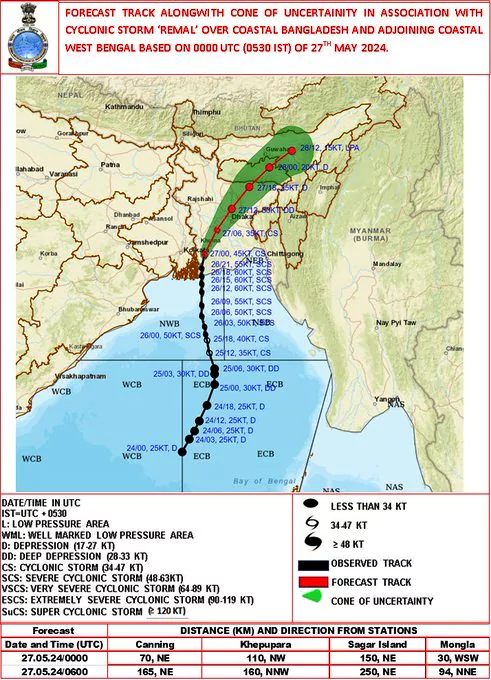Context
Recently, As per the prediction of The India Meteorological Department (IMD), Cyclone Remal hit the coasts of Bangladesh and West Bengal.
Cyclone Remal Latest Update

- It caused individuals to lose their lives, power outages, and inundation of Coastal areas.
- Remal is expected to steadily consolidate and intensify as it moves into a narrow zone of low wind shear in the northern portion of the Bay of Bengal.
About Cyclone Remal
Cycone remal is a tropical cyclone in the Northern Indian Ocean (Bay of Bengal).
- Remal means “sand” in Arabic.
- This naming follows a standard protocol for cyclones in the Bay of Bengal and Arabian Sea.
Enroll now for UPSC Online Course
Reason behind arrival and formation of Remal Cyclone
There are various reasons behind formation of Remal cyclone
- Sea Surface Warming: One of the main reasons for Remal’s formation and strengthening is the warming of sea water.
-
- As the sea surface temperature rises, it provides energy for cyclones to develop and intensify.
- Low Wind Shear: Strong winds at different altitudes can interfere with cyclone development.
- Areas with low wind shear create a more favorable environment for a storm to organize and strengthen.
- Moist Atmosphere: Tropical cyclones thrive on moisture in the atmosphere.
- Abundant moisture allows for condensation, which releases energy further fueling the storm.
- Atmospheric Instability: Certain atmospheric conditions create instability, allowing warm, moist air to rise rapidly.
- This rising air cools and condenses that forms clouds and releases energy that powers the cyclone.
Naming Cyclones in the North Indian Ocean:
- Panel on Tropical Cyclones (PTC): The World Meteorological Organization (WMO) formed the Panel on Tropical Cyclones (PTC) in 1972.
- Originally comprised eight member countries: Bangladesh, India, Maldives, Myanmar, Pakistan, Sri Lanka, Sultanate of Oman, and Thailand.
- Naming Cyclones:
- At the twenty-seventh session in 2000 in Muscat, Oman, the PTC decided to assign names to tropical cyclones in the Bay of Bengal and Arabian Sea.
- Cyclone naming started in 2004 after finalizing a list based on recommendations from panel countries.
- Expansion of the PTC:
- In 2018, the PTC expanded to include Iran, Qatar, Saudi Arabia, United Arab Emirates, and Yemen.
- Current Cyclone Naming List:
- In April 2020, a list of 169 cyclone names was released, with 13 suggestions from each of the 13 countries. This list is currently in use.
- Guiding Principles for Cyclone
- Neutrality: Proposed names should be neutral and not favour any particular political party, religion, culture, or gender.
- Sensitivity: Name should not hurt the sentiments of the people around the world.
- Respectful Tone: Name should be short, easy to pronounce and not offensive, cruel, and rude.
- Length Limit: Cyclones name can go to maximum eight letters long.
|
Impact of Cyclone Remal:
- Cyclone Remal’s landfall brought widespread destruction and disruption to coastal India and Bangladesh.
About Cyclone
Cyclone is a large air mass. It rotates around a central point of low atmospheric pressure.
- When viewed from above.
- In the Northern Hemisphere, it rotates Counterclockwise.
- In the Southern Hemisphere, it rotates clockwise.
Enroll now for UPSC Online Classes
Required condition for a Cyclone:
- Sea surface with high temperature (above 27^0).
- Presence of coriolis effect for the creation of a cyclonic vortex.
- Small variations in the vertical wind speed.
- Latent heat for driving storm’s energy
- Upper level divergence above the Sea Level System.
![]() 27 May 2024
27 May 2024

